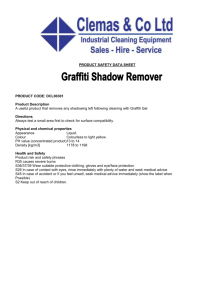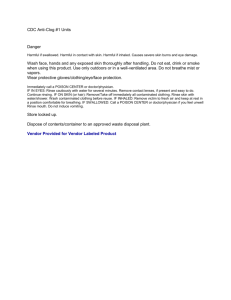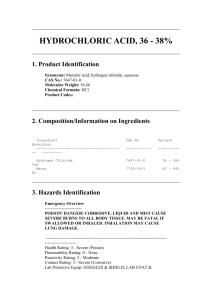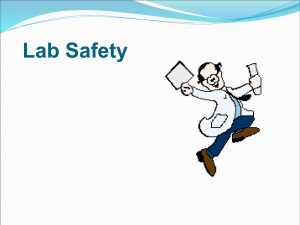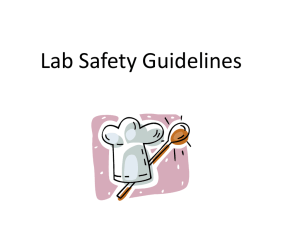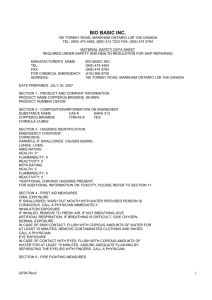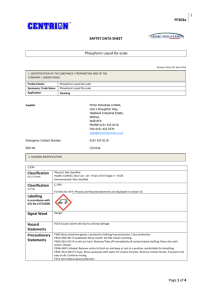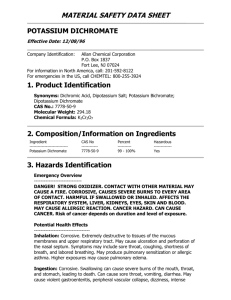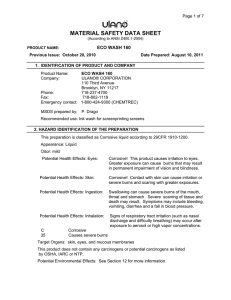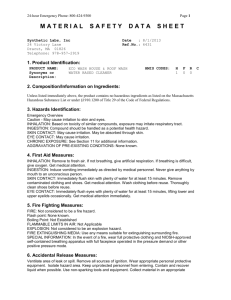Expel Warm Oven Cleaner
advertisement
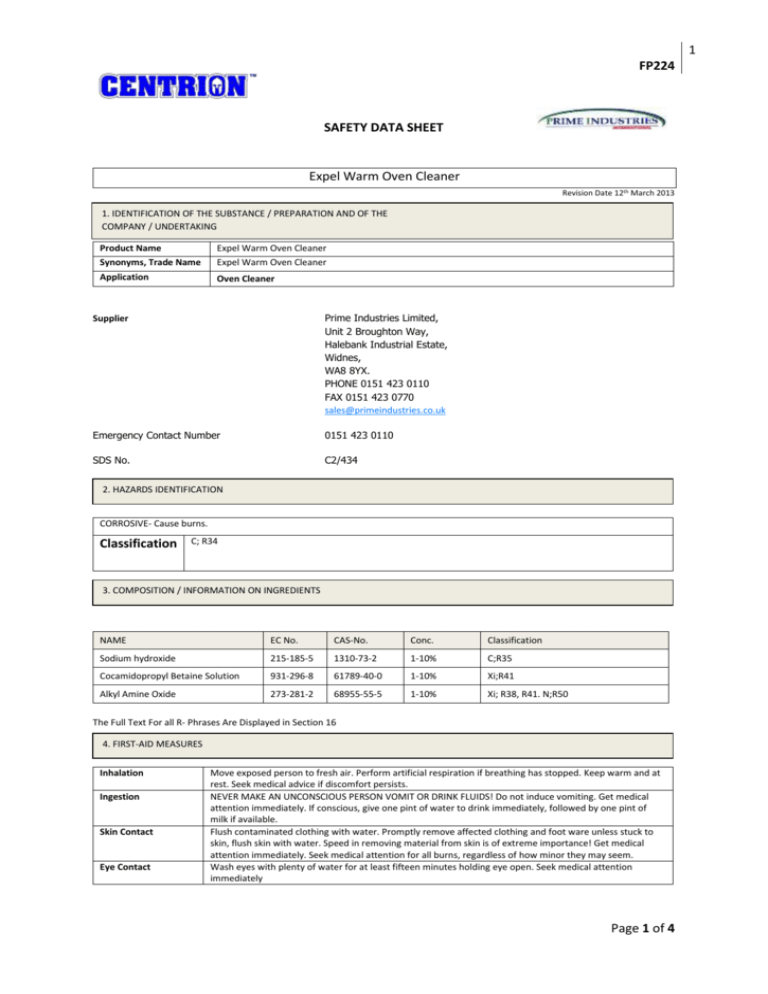
1 FP224 SAFETY DATA SHEET Expel Warm Oven Cleaner Revision Date 12th March 2013 1. IDENTIFICATION OF THE SUBSTANCE / PREPARATION AND OF THE COMPANY / UNDERTAKING Product Name Expel Warm Oven Cleaner Synonyms, Trade Name Expel Warm Oven Cleaner Application Oven Cleaner Supplier Prime Industries Limited, Unit 2 Broughton Way, Halebank Industrial Estate, Widnes, WA8 8YX. PHONE 0151 423 0110 FAX 0151 423 0770 sales@primeindustries.co.uk Emergency Contact Number 0151 423 0110 SDS No. C2/434 2. HAZARDS IDENTIFICATION CORROSIVE- Cause burns. Classification C; R34 3. COMPOSITION / INFORMATION ON INGREDIENTS NAME EC No. CAS-No. Conc. Classification Sodium hydroxide 215-185-5 1310-73-2 1-10% C;R35 Cocamidopropyl Betaine Solution 931-296-8 61789-40-0 1-10% Xi;R41 Alkyl Amine Oxide 273-281-2 68955-55-5 1-10% Xi; R38, R41. N;R50 The Full Text For all R- Phrases Are Displayed in Section 16 4. FIRST-AID MEASURES Inhalation Ingestion Skin Contact Eye Contact Move exposed person to fresh air. Perform artificial respiration if breathing has stopped. Keep warm and at rest. Seek medical advice if discomfort persists. NEVER MAKE AN UNCONSCIOUS PERSON VOMIT OR DRINK FLUIDS! Do not induce vomiting. Get medical attention immediately. If conscious, give one pint of water to drink immediately, followed by one pint of milk if available. Flush contaminated clothing with water. Promptly remove affected clothing and foot ware unless stuck to skin, flush skin with water. Speed in removing material from skin is of extreme importance! Get medical attention immediately. Seek medical attention for all burns, regardless of how minor they may seem. Wash eyes with plenty of water for at least fifteen minutes holding eye open. Seek medical attention immediately Page 1 of 4 2 FP224 5. FIRE-FIGHTING MEASURES Extinguishing Media Use: Unusual Fire & Explosion Hazards Use fire-extinguishing media appropriate for surrounding materials. None Specific Hazard In case of fire, toxic and corrosive gasses mat be formed. Protective Measures in Fire In case of fire, self contained breathing apparatus and full protective clothing must be worn. 6. ACCIDENTAL RELEASE MEASURES Personal Precautions Observe normal standards of industrial hygiene for handling chemicals. Do not breathe fumes. Avoid contact with skin and eyes The material is designed for commercial cleaning use and normal safe disposal to foul sewer. In the event of a spillage of a large amount of product, entry to surface water drainage should be avoided. Major spillage losses to surface drainage must be notified to the local waste authority. Absorb with inert material then scoop into suitable containers & label correctly. Cover the containers before moving. Dispose of containers by an appropriate method Flush the area with water. Run-off or release to foul sewer, waterway or ground forbidden. Environmental Precautions Spill Cleanup Methods 7. HANDLING AND STORAGE Usage Precautions Fire & Explosion Storage Precautions Avoid Spilling, skin and eye contact. Avoid acids, moisture and combustible materials. Wash at the end of each work shift and before eating, smoking and using the toilet. Wash promptly with soap if skin becomes contaminated. Eating, smoking and drinking – water fountains are prohibited in immediate work area. Always follow good personal hygiene practises when working with this product. No special measures Store in a cool dry area. Protect from light. External damage to containers should be avoided. Seal containers after use. Do not store close to strong oxidizing agents which could aggravate any fire situations. Use in a well ventilated area. Do not store product in direct sunlight. 8. EXPOSURE CONTROLS / PERSONAL PROTECTION NAME Std Sodium hydroxide Wel Cocamidopropyl Betaine Solution TWA – 8 hrs STEL – 15 min Notes 2mg/m3 Classified EH40 1ppm 2.9mg/m3 Wel= Workplace exposure limits Protective Equipment Engineering Measures Provide adequate ventilation Respiratory Equipment Respiratory protection may be required when excessive air contaminated occurs. Hand Protection Wear suitable gloves. Eye Protection Other Protection Hygiene Measures Wear safety goggles where eye exposure is reasonable probable. Wear suitable protective clothing to prevent skin contact. Do Not Smoke In Work Area! Wash at the end of each work shit and before eating, smoking and using the toilet. Wash promptly if skin becomes contaminated. Promptly remove any clothing that becomes contaminated. When using do not eat, drink or smoke. 9. PHYSICAL AND CHEMICAL PROPERTIES Appearance Thick liquid Colour Off white Odour Low odour Page 2 of 4 3 FP224 Solubility Freely pH value 13.5 - 14 10. STABILITY AND REACTIVITY Stability Conditions To Avoid Stable under normal temperature and recommended use Avoid excessive heat for prolonged periods of time Materials To Avoid Hazardous Decomposition Products Strong oxidising substances, strong acids Fire of high temperatures may form toxic and corrosive vapours 11. TOXICOLOGICAL INFORMATION Toxic Dose 1-ld 50 LD 50(Oral Rat) 325mg/kg Inhalation fumes can irritate the respiratory system, and may cause coughing and difficulties in breathing Ingestion Corrosive, may cause burns to mouth, oesophagus and stomach Skin Contact May cause serious chemical burns to the skin. Corrosive, prolonged contact causes serious tissue damage Eye Contact Causes burns. Risk of corneal damage, vision disturbances including blurred vision Chronic Effects Acute effects predominate 12. ECOLOGICAL INFORMATION Degradability Mobility Bio accumulating This product is biodegradable This product is soluble in water The product is not bio accumulating 13. DISPOSAL CONSIDERATIONS General Information Disposal Methods Do not wash into drains. Do not mix with other waste materials. Wear appropriate clothing, goggles and mask Arrange disposal as special waste by licensed disposal company, in consultation with local waste disposal authority, in accordance with control of pollution Act 1974 14. TRANSPORT INFORMATION Proper Shipping name Contains UN No. Road ADR Class No. ADR Class ADR Pack Group Tunnel Restriction Hazard No. (ADR) ADR Label No. Hazchem code Corrosive Liquid, N.O.S Sodium hydroxide solution UN No. Sea 1760 8 Class 8: Corrosive substance III (E) 80 8 2P IMDG Class IMDG Pack Group 1760 8 III EMS UN No. Air Air Class Air Sub Class Air Pack Group F-A, S-B 1760 8 8 III Page 3 of 4 4 FP224 15. REGULATORY INFORMATION Labelling Contains Risk Phrases Safety Phrases Statutory Instrument Approved code of practice National Regulations Corrosive Sodium hydroxide R34 – Causes burns R38 – Irritating to skin R41 – Risk of serious damage to eyes S2 – Keep away from children S26 – In case of contact with eyes, rinse immediately with plenty of water and seek medical advice. S28 – After contact with skin, wash immediately with plenty of water. S36/37/39 – Wear suitable protective clothing, gloves and eye/face protection. S45 – In case of accident or if you feel unwell, seek medical advice immediately (show the label where possible). Chemicals (Hazard information and packaging) regulations Safety data sheets for substances and preparations The Chemicals (Hazard information and packaging for supply) Regulations 2002 No. 1689. Workplace Exposure Limits 2005 (EH40) 16. OTHER INFORMATION REV. No. / REPL. SDS Generated SDS No. Safety Data Sheet Status Approved. Signature Risk Phrases in Full Notes 27th March 2012 C2/434 27th March 2012 R35 – Causes severe burns R38 – Irritating to skin R41 – Risk of serious damage to eyes R50 – Very toxic to aquatic organisms This information relates only to the specific material designed and may not be valid for such material used in combination with any other materials or in any process. Such information is to the best of the company’s knowledge and belief, accurate and reliable as of date indicated. However, no warranty, guarantee or representation is made as to its accuracy, reliability or completeness. It is the user’s responsibility to satisfy himself as to the suitability of such information for his own particular use. Page 4 of 4
